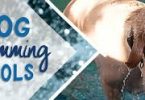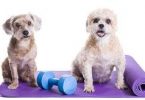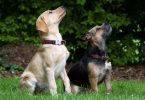 The AKC Star Puppy program was developed by the American Kennel Club to help puppy owners, breeders, instructors and other canine professionals to understand and meet the needs of the extraordinary, remarkable puppy! Star stands for Socialization, Training, Activity and Responsible Pet Ownership, everything a puppy and owner need to learn to have a wonderful, enjoyable life together.
The AKC Star Puppy program was developed by the American Kennel Club to help puppy owners, breeders, instructors and other canine professionals to understand and meet the needs of the extraordinary, remarkable puppy! Star stands for Socialization, Training, Activity and Responsible Pet Ownership, everything a puppy and owner need to learn to have a wonderful, enjoyable life together.
The program is for dogs up to one year old. It is the puppy level of Canine Good Citizen. You and your puppy will attend one class per week, for about an hour, for 6 weeks total. In between classes, you will need to practice what you’ve learned at home with your puppy several times per day. On the 6th week, the last class, the AKC Certified Instructor will test you and your puppy on twenty Star Puppy items. Upon passing all twenty items, you will complete the paperwork to have your puppy listed in the AKC Star Puppy Archives. You will receive a AKC certificate, a monthly email newsletter and a beautiful gold AKC Star Puppy medal.
AKC Star Puppy and Canine Good Citizen Evaluators are experienced dog trainers. They must meet several criteria including having a minimum of two years experience teaching people and their dogs in a professional or educational capacity.
Raising a puppy is hard work and dedication, it requires a lot of time and energy, and can most certainly be a challenge. The Star Puppy Program will teach you how to get your puppy started on a responsible, fun filled journey and human bond that will last a lifetime.
Characteristics Of A Star Puppy
Most people would like a puppy that exudes confidence, has good manners, is potty and crate trained, is happy, friendly and healthy. A puppy that is afraid of his own shadow, afraid of everything and everyone around him, barks incessantly, jumps up on you and visitors, destroys your house and bites and nips is not a pleasure to be around.
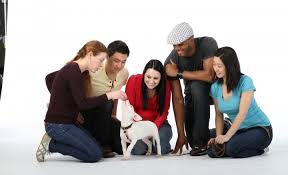 Socialization: is one of the first and most important things to teach your puppy. This is a skill that will follow him throughout his lifetime. Socializing your puppy means exposing him to a variety of people, places and things in his environment. Most owners think that meeting other family members is enough socialization, however you want to expose your puppy to as many different types of people possible. People of different sizes, shapes and colors. People wearing hats and sunglasses, people riding bikes, walking with crutches and riding skateboards. Children, babies and other dogs and pets, including cats. The more the better. Socialization is most important during the first 3 months of life. Failure to be exposed at an early age to these kind of things he will encounter late in life makes it much more difficult for your puppy to learn to cope with everyday life later on.
Socialization: is one of the first and most important things to teach your puppy. This is a skill that will follow him throughout his lifetime. Socializing your puppy means exposing him to a variety of people, places and things in his environment. Most owners think that meeting other family members is enough socialization, however you want to expose your puppy to as many different types of people possible. People of different sizes, shapes and colors. People wearing hats and sunglasses, people riding bikes, walking with crutches and riding skateboards. Children, babies and other dogs and pets, including cats. The more the better. Socialization is most important during the first 3 months of life. Failure to be exposed at an early age to these kind of things he will encounter late in life makes it much more difficult for your puppy to learn to cope with everyday life later on.
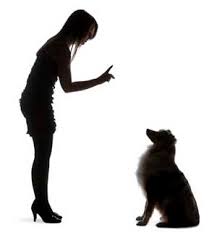 Training: Training your puppy while he is young is much easier to do than solve problems that have developed after he has started to mature. Puppies can start classes as early as 7-8 weeks of age provided they are healthy and have received their first set of vaccinations and first de-worming seven days prior to the first class. Waiting to long to begin training and socializing can result in behavioral issues such as fears, phobia’s, aggression and avoidance. It is recommended that all members of the family attend the Star classes. This way you will all be on the same page for their training. Your puppy will be taught the basic commands of sit, down, stay, stand, leave it, come and walking on a loose leash. He will also be allowed the opportunity to receive plenty of play, exercise and socialization activities. “A tired dog is a good dog” Dogs who are bored and have lots of pent up energy are more likely to get into trouble when they have to create their own activities.
Training: Training your puppy while he is young is much easier to do than solve problems that have developed after he has started to mature. Puppies can start classes as early as 7-8 weeks of age provided they are healthy and have received their first set of vaccinations and first de-worming seven days prior to the first class. Waiting to long to begin training and socializing can result in behavioral issues such as fears, phobia’s, aggression and avoidance. It is recommended that all members of the family attend the Star classes. This way you will all be on the same page for their training. Your puppy will be taught the basic commands of sit, down, stay, stand, leave it, come and walking on a loose leash. He will also be allowed the opportunity to receive plenty of play, exercise and socialization activities. “A tired dog is a good dog” Dogs who are bored and have lots of pent up energy are more likely to get into trouble when they have to create their own activities.
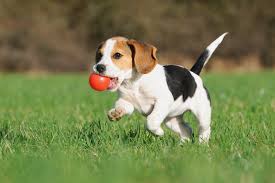 Activity: Bored puppies tend to get into trouble. Providing adequate stimulation and activities for your puppy is critical to his proper development. Exercise is one of the key components in Star Puppy. Activity means play and exercise, both mentally and physically. Play does not have to be done outside. There are lots of fun activities you can do with your puppy indoors. Daily needs for exercise will depend on your puppies age and breed. The exercise and play schedule for your puppy should revolve around your families schedule making it easier for you to find time to spend with your puppy. If you live in a busy family household, school, sports, work, it is a good idea to make up a daily schedule listing your puppies activities with the family members name by it who will be responsible for that specific activity. This way your puppies training and socialization will not be forgotten or overlooked. A general guideline for puppy exercise is at least twice a day for about 15 to 30 minutes. Putting a puppy outside in a fenced yard may not provide adequate exercise for your puppy if he is not moving around sufficiently on his own. Barking at the neighbors and digging up your garden are not healthy forms of exercise. Taking a nice walk, playing ball, Frisbee, tug or fetch are just a few fun outdoor activities. Exercise is beneficial for physical growth. Exercise improves and maintains flexibility along with building strong muscles, joints and bones. Exercise aids in digestion. Moving improves mobility in the gastrointestinal tract. It keeps everything moving so the puppy doesn’t get constipated. Exercise strengthens the heart and helps with your puppies breathing. Exercise helps control your puppies weight and results in a restful sleep, which is necessary to maintain good health.
Activity: Bored puppies tend to get into trouble. Providing adequate stimulation and activities for your puppy is critical to his proper development. Exercise is one of the key components in Star Puppy. Activity means play and exercise, both mentally and physically. Play does not have to be done outside. There are lots of fun activities you can do with your puppy indoors. Daily needs for exercise will depend on your puppies age and breed. The exercise and play schedule for your puppy should revolve around your families schedule making it easier for you to find time to spend with your puppy. If you live in a busy family household, school, sports, work, it is a good idea to make up a daily schedule listing your puppies activities with the family members name by it who will be responsible for that specific activity. This way your puppies training and socialization will not be forgotten or overlooked. A general guideline for puppy exercise is at least twice a day for about 15 to 30 minutes. Putting a puppy outside in a fenced yard may not provide adequate exercise for your puppy if he is not moving around sufficiently on his own. Barking at the neighbors and digging up your garden are not healthy forms of exercise. Taking a nice walk, playing ball, Frisbee, tug or fetch are just a few fun outdoor activities. Exercise is beneficial for physical growth. Exercise improves and maintains flexibility along with building strong muscles, joints and bones. Exercise aids in digestion. Moving improves mobility in the gastrointestinal tract. It keeps everything moving so the puppy doesn’t get constipated. Exercise strengthens the heart and helps with your puppies breathing. Exercise helps control your puppies weight and results in a restful sleep, which is necessary to maintain good health.
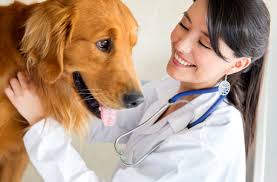 Responsibility: You are solely responsible for your puppies health and well being. All puppies should have routine veterinary care which includes check ups and vaccines. You should feed a high quality diet and provide clean drinking water. Your first priority should always be keeping your puppy safe from harm and danger. You should never allow your dog to run loose and you should always keep him on leash in public. He should have a minimum of two forms of identification on him at all times in the event he becomes separated from you. You should never allow your puppy to run loose in the neighborhood terrorizing other dogs, children and the elderly. Do not allow your dog to bark all day becoming a nuisance. Always dispose of your dogs waste in public areas such as walking trails, parks, hotels and most importantly, your neighbors lawn. You should provide basic training, attention and playtime for your puppy. Dogs are a lifetime of commitment. They require time, care and money. If you are not up to the job, please do not get a puppy. Get a pet turtle!
Responsibility: You are solely responsible for your puppies health and well being. All puppies should have routine veterinary care which includes check ups and vaccines. You should feed a high quality diet and provide clean drinking water. Your first priority should always be keeping your puppy safe from harm and danger. You should never allow your dog to run loose and you should always keep him on leash in public. He should have a minimum of two forms of identification on him at all times in the event he becomes separated from you. You should never allow your puppy to run loose in the neighborhood terrorizing other dogs, children and the elderly. Do not allow your dog to bark all day becoming a nuisance. Always dispose of your dogs waste in public areas such as walking trails, parks, hotels and most importantly, your neighbors lawn. You should provide basic training, attention and playtime for your puppy. Dogs are a lifetime of commitment. They require time, care and money. If you are not up to the job, please do not get a puppy. Get a pet turtle!
Owner Behaviors-Test Items
 Item#1-Proof that puppy is in the care of a Veterinarian. Has had an exam and first set of puppy vaccines. Owner is required to present proof of vaccines.
Item#1-Proof that puppy is in the care of a Veterinarian. Has had an exam and first set of puppy vaccines. Owner is required to present proof of vaccines.
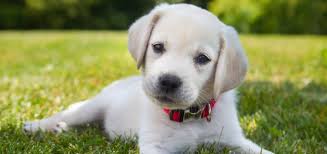 Item#2-Puppy appears healthy and active for it’s breed. The puppy needs to be reasonably active and in general good health.
Item#2-Puppy appears healthy and active for it’s breed. The puppy needs to be reasonably active and in general good health.
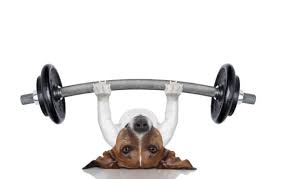 Item#3-Owner describes daily exercise and play plan. During any of the classes the owner is asked to describe an play and exercise program appropriate for their puppy. The instructor will give feedback regarding how puppies should get adequate exercise.
Item#3-Owner describes daily exercise and play plan. During any of the classes the owner is asked to describe an play and exercise program appropriate for their puppy. The instructor will give feedback regarding how puppies should get adequate exercise.
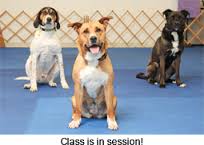 Item#4-Owner and puppy attend 6 training classes taught by an AKC STAR Puppy evaluator. Owners and puppy must attend a minimum of 6 training classes.
Item#4-Owner and puppy attend 6 training classes taught by an AKC STAR Puppy evaluator. Owners and puppy must attend a minimum of 6 training classes.
 Item#5-Owner brings bags to class for cleaning up after puppy. During the classes the evaluator will observe to make sure owners bring clean up bags. When their is an accident, the evaluator will observe to make sure owner cleans up after their puppy.
Item#5-Owner brings bags to class for cleaning up after puppy. During the classes the evaluator will observe to make sure owners bring clean up bags. When their is an accident, the evaluator will observe to make sure owner cleans up after their puppy.
 Item#6-Owner has obtained some form of ID for the puppy. By the end of the 6th class owners must have either a collar with an ID tag, a microchip, or tattoo.
Item#6-Owner has obtained some form of ID for the puppy. By the end of the 6th class owners must have either a collar with an ID tag, a microchip, or tattoo.
Puppy Behaviors-Test Items
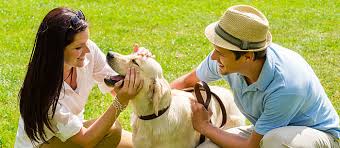 Item#7-Free of aggression toward people. At the last class, the evaluator will score the puppies performance over the last 6 weeks. In cases where there is people aggression, the evaluator will work directly with owner and puppy to solve the problem. If the problem is beyond what the evaluator can solve in a group setting, private lessons may be recommended.
Item#7-Free of aggression toward people. At the last class, the evaluator will score the puppies performance over the last 6 weeks. In cases where there is people aggression, the evaluator will work directly with owner and puppy to solve the problem. If the problem is beyond what the evaluator can solve in a group setting, private lessons may be recommended.
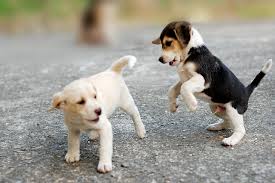 Item#8-Free of aggression toward puppies. At the last class, the evaluator will score the puppies performance over the last 6 weeks. In cases where there is puppy aggression, the evaluator will work directly with owner and puppy to solve the problem. If the problem is beyond what the evaluator can solve in a group setting, private lessons may be recommended.
Item#8-Free of aggression toward puppies. At the last class, the evaluator will score the puppies performance over the last 6 weeks. In cases where there is puppy aggression, the evaluator will work directly with owner and puppy to solve the problem. If the problem is beyond what the evaluator can solve in a group setting, private lessons may be recommended.
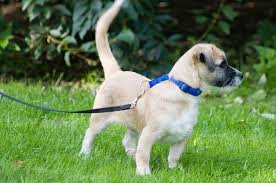 Item#9-Tolerates collar, harness or head collar-owners choice. The evaluator must indicate if puppy will tolerate wearing a collar or harness of owners choice. For test purposes, puppy must wear a buckle or slip collar.
Item#9-Tolerates collar, harness or head collar-owners choice. The evaluator must indicate if puppy will tolerate wearing a collar or harness of owners choice. For test purposes, puppy must wear a buckle or slip collar.
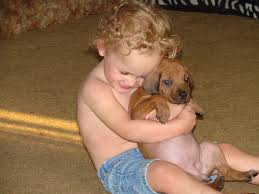 Item#10-Owner can hug or hold puppy. Puppy must tolerate being hugged or held by owner.
Item#10-Owner can hug or hold puppy. Puppy must tolerate being hugged or held by owner.
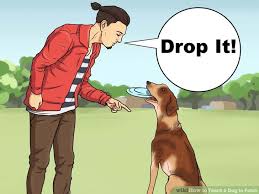 Item#11-Puppy allows owner to take away treat or toy. Puppy must allow owner to take away a favorite toy or treat. Puppy may try to hold onto toy or treat, but may not growl, bite or snap.
Item#11-Puppy allows owner to take away treat or toy. Puppy must allow owner to take away a favorite toy or treat. Puppy may try to hold onto toy or treat, but may not growl, bite or snap.
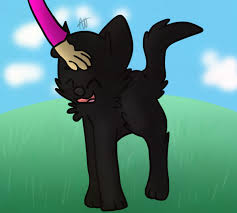 Item#12-Allows petting by a person other than the owner. Puppy must allow someone other than the owner to pet them. Squirming and wiggling is okay, but any signs of aggression are not permitted.
Item#12-Allows petting by a person other than the owner. Puppy must allow someone other than the owner to pet them. Squirming and wiggling is okay, but any signs of aggression are not permitted.

Item#13-Grooming-Allows owner handling and a brief exam. The puppy must allow the owner to handle their feet and ears.
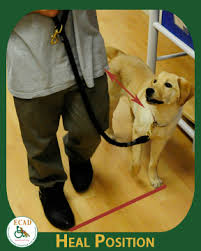 Item#14-Walks on a leash-follows owner on lead in a straight line. The owner will walk 15 steps with the puppy following on a loose leash. Puppy does not have to be in heel position Puppy may not lunge forward or lag behind. Owner may talk to and praise puppy at any time throughout any of the test items.
Item#14-Walks on a leash-follows owner on lead in a straight line. The owner will walk 15 steps with the puppy following on a loose leash. Puppy does not have to be in heel position Puppy may not lunge forward or lag behind. Owner may talk to and praise puppy at any time throughout any of the test items.
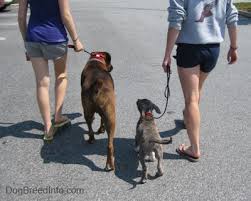 Item#15-Walks by other people-walks on leash past people that are 5 ft. away. The puppy may not lunge at people or pull excessively to go to them.
Item#15-Walks by other people-walks on leash past people that are 5 ft. away. The puppy may not lunge at people or pull excessively to go to them.
 Item#16-Sits on command-Owner may use a food lure. Food lures are permitted however owner may not push the puppy into position by pushing hard on the hips to force the dog to sit.
Item#16-Sits on command-Owner may use a food lure. Food lures are permitted however owner may not push the puppy into position by pushing hard on the hips to force the dog to sit.
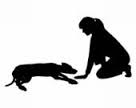 Item#17-Down on command-may use food lure. Puppy must lay down on command. The owner is not permitted to force puppy into down by jerking their front legs from underneath them.
Item#17-Down on command-may use food lure. Puppy must lay down on command. The owner is not permitted to force puppy into down by jerking their front legs from underneath them.
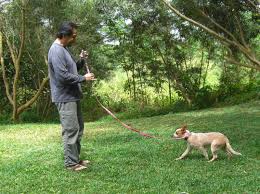 Item#18-Comes to owner from 5 ft. when name is called. Puppy must come to owner from 5 feet. The owner may get on his hands and knees, clap or make noises to get the puppy to come.
Item#18-Comes to owner from 5 ft. when name is called. Puppy must come to owner from 5 feet. The owner may get on his hands and knees, clap or make noises to get the puppy to come.
 Item#19-Reaction to distractions-distractions are presented to puppy from 15 feet away. Evaluator will present some distraction. Swinging a shopping bag or dropping a chair are two common distractions used in the test.
Item#19-Reaction to distractions-distractions are presented to puppy from 15 feet away. Evaluator will present some distraction. Swinging a shopping bag or dropping a chair are two common distractions used in the test.
 Item#20-Stay on leash with another person while owner walks 10 steps away and returns back to puppy. The puppy can show mild signs of distress, but they should not have an extreme reaction.
Item#20-Stay on leash with another person while owner walks 10 steps away and returns back to puppy. The puppy can show mild signs of distress, but they should not have an extreme reaction.
Elle Harris-AKC



